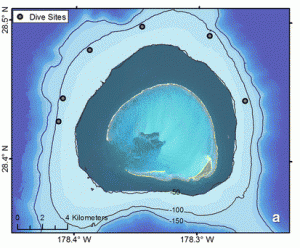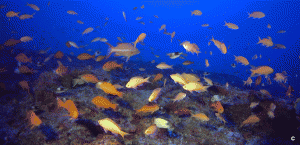Many Endemic Species Found at Papahānaumokuākea

Location of mesophotic fish survey sites around Kure Atoll. Photo source: “100% endemism in mesophotic reef fish assemblages at Kure Atoll, Hawaiian Islands”
Scientists have discovered globally significant abundances of unique Hawaiian fishes among deep coral reefs in Papahānaumokuākea Marine National Monument, which encompasses 140,000 square miles of ocean waters, including ten islands and atolls of the Northwestern Hawaiian Islands.
The scientific journal “Marine Biodiversity” recently published a study documenting deep coral reef fish communities composed exclusively of species unique to Hawai‘i. These enemic communities represent a globally significant reservoir of biodiversity.
Scientists refer to species with restricted geographic ranges as endemic; Hawaiian endemics are those species that are only found in Hawai‘i and nowhere else.
“This the highest level of endemism recorded from any marine ecosystem on Earth,” said Randall Kosaki, PhD., first author on the study and NOAA’s Office of National Marine Sanctuaries deputy superintendent for Papahānaumokuākea Marine National Monument. “Hawai‘i’s one of the most remote archipelagos on our planet, so we have many, many species here that are not found anywhere else.”

100% endemic reef fish assemblage at 90 meters, including Pseudanthias thompsoni, Odontanthias fuscipinnis,Caprodon unicolor, Chromis struhsakeri, Genicanthus personatus, Chaetodon miliaris,Bodianus albotaeniatus, B. bathycapros, and B. sanguineus. Photo source: “100% endemism in mesophotic reef fish assemblages at Kure Atoll, Hawaiian Islands”
Fish communities referenced in the study were documented at depths of 300 feet at Kure Atoll, the northernmost of the remote, uninhabited Northwestern Hawaiian Islands. Kure Atoll lies about 1,300 miles northwest of Honolulu.
The discovery was made on a research expedition aboard NOAA Ship Hi‘ialakai last fall. Divers using advanced, closed-circuit rebreather dive technology conducted dives at depths far beyond the range of most scientific or recreational scuba divers.
Deep coral reefs at depths of 150 to 450 feet, also known as “the coral reef twilight zone,” are among the most poorly explored of all marine ecosystems. Deeper than most scuba divers can venture and shallower than most submersible-based exploration, these reefs represent a new frontier for coral reef research.
The article, entitled, “100% Endemism in Mesophotic Reef Fish Assemblages at Kure Atoll, Hawaiian Islands,” can be accessed online.

100% endemic reef fish assemblage at 90 meters, including Pseudanthias thompsoni, Odontanthias fuscipinnis,Caprodon unicolor, Chromis struhsakeri, Genicanthus personatus, Chaetodon miliaris,Bodianus albotaeniatus, B. bathycapros, and B. sanguineus. Photo source: “100% endemism in mesophotic reef fish assemblages at Kure Atoll, Hawaiian Islands”
For more information, visit www.papahanaumokuakea.gov.
Papahānaumokuākea is cooperatively managed to ensure ecological integrity and achieve strong, long-term protection and perpetuation of Northwestern Hawaiian Island ecosystems, Native Hawaiian culture, and heritage resources for current and future generations.
Three co-trustees—the US Department of Commerce, US Department of the Interior and State of Hawai‘i—joined by the Office of Hawaiian Affairs, protect this special place.
Papahānaumokuākea Marine National Monument was inscribed as the first mixed (natural and cultural) UNESCO World Heritage Site in the United States in July 2010.













